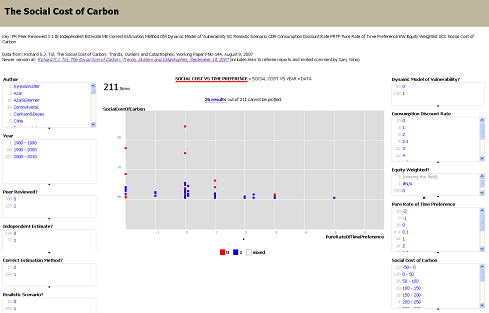I recently discovered a cool set of tools from MIT’s Simile project. My favorites are Timeline and Exhibit, which provide a fairly easy way to create web sites where visitors can interact with data. As a test, I built an Exhibit containing Richard Tol’s survey of assessments of the social cost of carbon (SCC):
Tol concludes:
This paper presents an update of an earlier meta-analysis (Tol, 2005) of the social cost of carbon. Besides more data and more advanced statistical analysis, this paper offers four results. Firstly, there is a downward trend in the estimates of the social cost of carbon ’“ even if the IPCC (Schneider et al., 2007) would like to believe the opposite. Secondly, the Stern Review (Stern et al., 2006) is an outlier ’“ and its impact estimates are pessimistic even when compared to other studies in the gray literature and other estimates that use low discount rates. Thirdly, the uncertainty about the social cost of carbon is so large that the tails of the distribution may dominate the conclusions (Weitzman, 2007) ’“ even though many of the high estimates have not been peer-reviewed and use unacceptably low discount rates. Fourthly, if everyone were to pay a carbon tax equal to the social cost of carbon (but not reduce emissions), there is a fair chance that annual taxes would exceed annual income for many people.
There are three implications. Firstly, greenhouse gas emission reduction today is justified. The median of the Fisher-Tippett kernel density for peer-reviewed estimates with a 3% pure rate of time preference and without equity weights, is $20/tC. This compares to a future price of carbon permits of $8/tC in the European Union (and a spot price of ¢3/tC). The case for intensification of climate policy can be made with conservative assumptions. One does not have to rely on dodgy analysis as in Schneider et al. (2007) and Stern et al. (2006). Secondly, the uncertainty is so large that a considerable risk premium is warranted. With the conservative assumptions above, the mean equals $23/tC and the certainty-equivalent $25/tC. More importantly, there is a 1% probability that the social cost of carbon is greater than $78/tC. This number rapidly increases if we use a lower discount rate ’“ as may well be appropriate for a problem with such a long time horizon ’“ and if we allow for the possibility that there is some truth in the scare-mongering of the gray literature. Thirdly, more research is needed into the economic impacts of climate change ’“ to eliminate that part of the uncertainty that is due to lack of study, and to separate the truly scary impacts from the scare-mongering. Papers often conclude with a call for more research, and often this is a call for funding for the authors or a justification for further papers by the authors. In this case, however, quality research by newcomers in the field would be particularly welcome.
This survey is sometimes cited as evidence that the social cost of carbon is low, and thus not really worth worrying about. However, that conclusion conflates costs (the stream of material climate damages) with a value judgment (the weight assigned to damages in different times and places). The conflation is necessary if one wants to reduce a stream of damages across time and space to a single number, but the value judgment is a major component of the outcome. For a study with a century time scale, the 3% pure rate of time preference (PRTP) above equates to a 95% discount, i.e. that one unit of welfare today would be adequate compensation for the loss of twenty units at the end of the century. Offsetting choices make the ultimate difference to SCC less dramatic (unless one considers scenarios with low or no GDP growth), but still the SCC for studies with 0% PRTP is more than 5x that for studies with 3% PRTP (which you can demonstrate for yourself in the Exhibit).
The usual defense of discounting welfare involves revealed preference: if we observe that people make decisions as if they don’t care about future generations, that must be an expression of their desires, and who are we to contradict the people? Of course, if we routinely make policy in this way, the system becomes neatly circular: we act as if the future doesn’t matter because we observe action as if the future doesn’t matter. It’s actually worse than that, because observations generally involve aggregate outcomes not individual people; to rely on such data as a guide to behavior one must also believe that markets faithfully express individual desires, and that individuals can reliably translate their existential needs into correct actions.
Tol offers some additional caveats:
Although there are now over 200 estimates of the SCC, research in this area is still less developed than one would wish. The 200 estimates of the marginal costs of climate change are based on a dozen of estimates of the total costs of climate change (’¦). The total cost estimates omit some impacts of climate change; they tend to ignore interactions between different impacts, and neglect higher order effects on the economy and population; they rely on extrapolation from a few detailed case studies; they often impose a changing climate on a static society; they use simplistic models of adaptation to climate change; they often ignore uncertainties; and they use controversial valuation methods and benefit transfers. Unfortunately, this list of caveats has not changed much since Fankhauser and Tol (1996). The proximate reason is that few people work in this area, and none full time, as funding is difficult to get. The ultimate reasons are, firstly, that the issues are complex and uncertain, and require broad multidisciplinary knowledge and, secondly, that the results are unpopular with climate policy makers.
Given the uncertainty in this kind of work, it’s surprising that so much more of the energy of the climate debate focuses on climate science instead.

